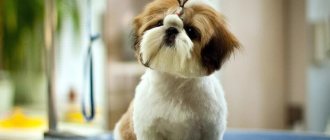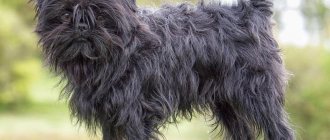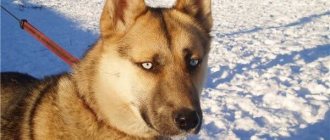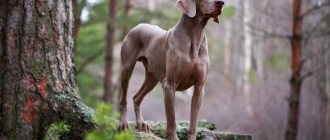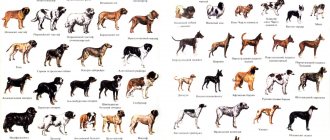Which breed should I choose?
In order to decide on the choice of a miniature dog breed, you first need to decide for yourself how much time you are willing to devote to caring for your pet and what money you are willing to spend.
For example, keeping dogs with long hair requires the owner to spend a lot of time and money.
To make your pet look beautiful and well-groomed, the services of a groomer may be required.
For dogs of short-haired and hairless breeds, a separate expense item is the purchase of overalls and other clothing for dogs for the cold season.
And of course, you need to decide for yourself how small your four-legged friend will really be.
| Small breeds: | Miniature dog breeds: |
|
|
In our online store you can find everything you need to keep your pet comfortable: food, beds, clothes, leash and other accessories.
Other recommendations regarding walking:
— Clothes for dogs should be appropriate for the season. Overalls, raincoats, jackets, suits, sweaters, pants, hats, T-shirts, dresses - this is a wide list. It is necessary to select it taking into account anatomical features; clothing should not hinder movements, including active ones: bouncing, running, spinning. There are practical composite models that are divided into elements. So, in cold weather, you should give preference to overalls consisting of a jacket and pants, and if it is warm, you can only wear a jacket and special shoes on your feet. If it is cool or cold, then a hat or blanket is required.
— The walking time varies, depending on the condition and mood of the animal. Experts recommend walking for 30 minutes to 1.5 hours. While in the fresh air, monitor your dog’s behavior; if he is tired, he will stop more often and try to lie down.
— By the way, small breeds are very trainable, and, for example, the poodle is considered the most trainable dog; its receptivity to training is even higher than that of the shepherd dog, which is traditionally used by the special services. If you are training an animal, you can increase the walking time to 2 hours by combining periods of learning tricks and short five-minute rests.
- You can and even need to use a leash. But you need to get used to it gradually so that everything feels natural. It will protect the “baby” from the aggression of other animals, it will not run away, plus, it has a positive effect on skills, since the pet will learn to be close to the owner within sight. If there is no danger of attack, then the leash can be removed.
As you can see, small breeds have their own characteristics, but all of them undoubtedly bring joy to their owners.
return to section
Features and benefits of keeping small dogs
Recently, dwarf dogs have become simply mega-popular. This popular love is explained by the fact that in a small city apartment a miniature dog does not embarrass its owners.
It’s not difficult to go on vacation with them; they behave well in society, keeping us company while shopping and even during negotiations.
Another undoubted advantage of owning a small dog is the ability to train your pet to a litter tray. In this case, the dog can be walked when possible, and not out of necessity.
However, dogs of dwarf breeds also have many disadvantages that you need to know about so as not to be disappointed after purchasing an animal.
So, the disadvantages of small dogs can be considered:
• Aggression and cockiness of some individuals
• Need for professional feed and special diet
• Joint fragility
• High cost of accessories, pet care products and the puppies themselves.
How to understand your small dog and how to care for it?
See the world through her eyes
Try getting down to your dog's level—literally—and take a good look around. The sofa hangs overhead, and the slippery kitchen floor seems to stretch for miles. This is your pet's environment, so it is important to look at things from her perspective. Ask yourself a few key questions:
- Do things look a little scarier from here? With people and household items hanging overhead, things can get a little scary - imagine a vacuum cleaner that's bigger than you to get an idea of how your little one might feel.
- How far are essential items, such as a water bowl, from main resting or play areas? Short sprint or marathon distance?
- If your dog is allowed to climb on furniture, how high does he have to jump? Would she need an extra step to climb onto the sofa?
All shapes and sizes
Small, miniature and toy breeds are a celebration of the diversity of mini dog shapes.
Some are small and robust, such as Jack Russell Terriers, French Bulldogs or West Highland White Terriers.
Other breeds, such as Italian Greyhounds, Prague Ratdogs and Chihuahuas, can be quite vulnerable and fragile, naturally requiring careful and gentle handling.
Some breeds have special distinctive features - for example, the easily recognizable long-bodied Dachshund, the round-headed Japanese Chin or the hairless Chinese Crested.
Whatever the size and shape of your pet, be sure to consider her needs when choosing the size and shape of her bed, food and water bowls, leash and collar or harness, temperature requirements, and more.
Little Napoleons
Being a small dog in a big world is not an easy task. However, small dogs often get away with unruly or dangerous behavior that is completely unacceptable in their larger dogs. Often these little Napoleons behave this way initially as a kind of defense, but later this behavior can quickly develop into a habit if it is not corrected at an early stage. Owners should remember that pulling on the leash, running away when called, growling or biting are all equally bad behaviors, whether in a two-pound Chihuahua or a fifty-pound Rottweiler. In both cases, proper socialization and training can work wonders.
Learning and practicing appropriate behavior in a variety of situations from an early age will help dogs of any size feel calm and relaxed at home, helping to prevent unwanted or downright dangerous behavior. Seek help from a trainer who knows your breed, or look for local group training classes.
Less is more
Small breeds have different calorie needs than large dogs. Since they have more surface area per pound than larger dogs, they tend to expend energy more quickly to stay warm, etc. They also expend more energy even just moving around. It takes your neighbor's Labrador 100 steps to walk to the end of the block, while your Lhasa Apso may need 400 steps to cover the same distance.
Small dogs may require more calories per pound of body weight per day than larger dogs, but you still need to make sure they don't become overweight. Obesity is just as dangerous for small dogs as it is for large ones.
Pocket puppies
These tiny babies need more calories for every 28 grams of body weight, but they cannot store energy as well as larger breed puppies, so they need to be fed more often and with more calories.
Mini breed puppies should be fed small but frequent meals throughout the day to compensate for their small stomach capacity and limitless energy requirements. Measure servings according to food label recommendations and consult with your veterinarian about your baby's individual needs.
Small mini-breed puppies, like babies of any breed, should be protected and cared for, but not overprotected. While it may take some willpower to look into the big brown eyes of a small, fluffy Cavalier King Charles Spaniel puppy and say “No!”, it has to be done. Training small breed dogs at an early age lays the foundation for a calmer, more reliable and well-behaved companion in the future.
Long and prosperous life
Small dogs often live much longer than their medium and large breeds. It is well known that Maltese dogs, Chihuahuas, Yorkshire terriers and miniature dachshunds live more than 12 years. The average lifespan of miniature poodles and border terriers is almost 14 years, with some centenarians reported to live up to almost 20 years, which is certainly respectable!
Because such long lives are often combined with city living, small dogs need extra protection to maintain good health into old age. Between regular veterinary visits, small dogs can benefit from extra antioxidants to help them combat the effects of aging and city life.
Proper nutrition
The smaller kibble size of our miniature dog foods is specifically designed for tiny doggies, allowing small dogs of any breed to easily grasp and chew the kibble.
Choosing a complete dog food with the perfect blend of antioxidants, omega-3 and omega-6 fatty acids, small kibble sizes and nutritional content tailored to your pet's age, combined with a tempting taste, ensures your dog gets exactly what he needs. she needs it for a long and happy life. To improve the health of small dogs, we have a wide range of Science Plan foods for daily nutrition for healthy pets, as well as Prescription Diet (for a successful weight loss and maintenance program and for healthy digestion).
Walking area in the apartment
You cannot force your dog to lie in his place all the time. She desperately needs communication, especially small pets. Therefore, the rules for caring for puppies in an apartment include regular time spent with the baby.
If the puppy is running around, there is no need to stop him. But, it is still necessary to accustom the baby to a certain place for games. The dog owner will not always be at home and pay attention to the puppy. Therefore, the apartment must have a special dog playpen. You can simply fence off any corner in the room and teach your baby to spend time in it.
Animal psychologists do not recommend locking dogs in a room, especially at an early age, when the psyche is not yet formed. Dogs are terrified of closed spaces. They are lost, nervous, and in the hope of somehow getting out, the dog will scratch the door, bark, howl and chew everything. When leaving, you should leave the door to the room open, but at the same time give the command “place”.
It is highly undesirable to leave a small puppy alone for a long time. He will lose faith in the owner, there will be no close contact and trust. Such dogs are difficult to train, sometimes even impossible.
Bathing dogs
Caring for a dog's coat also includes bathing. The frequency of bathing also depends on the dog's coat type.
For long-haired dogs with hair prone to tangles, more frequent bathing and thorough brushing are recommended; for short-haired dogs, bathing is more rare, about once a month. Bathing water should correspond to the dog’s body temperature and vary between 37.5-39°C.
Long-haired dogs should be blow-dried; short-haired dogs should be thoroughly wiped with a terry towel.
There are a wide variety of specialty shampoos and conditioners available to suit coat types and grooming needs. You can get more detailed information at a pet store or grooming salon.
Japanese Chin
The Japanese Chin can live in an apartment all its life.
A small domestic dog with a disproportionate physique, a “flat” muzzle and bulging eyes is a descendant of the imperial favorites. For many centuries, an entire army of servants protected the court dogs from the slightest stress, trying to please the next Japanese ruler. According to experts, a subservient attitude is the reason why Japanese Chins are fearless.
- In order to boldly rush at the enemy, it is enough for the dog to suspect that even the most insignificant threat hangs over its owner. Rushing into an attack, the little dog does not look at the temperament or size of the enemy. It is noteworthy that the Chin is never the first to get into a fight.
- In everyday life, the big-eyed Japanese Chin is quite good-natured, friendly, unpretentious and clean. It is easy to train him to the tray.
- Sometimes a dog shows character and defends its interests to the point of declaring a hunger strike. This behavior is the result of centuries of sycophancy that surrounded the dog’s distant ancestors.
The owner should not pay attention to the “ambitions” of the pet. By showing constant care and affection, a person will very quickly become a friend of the imperial dog. The Japanese Chin knows how to be loyal and is easy to train - within a 20-minute training he is able to master 1-2 commands.
The “couch dog” (as the breed is sometimes called) does not need a special diet and can spend its entire life indoors - long walks only tire it.
Additional Information. When developing a feeding system for their ward, owners should take into account that the chin does not swallow food whole, like its relatives, but chews every piece thoroughly.
Chin does not require special care, as it practically does not shed and has no characteristic odors.
- Care comes down to brushing (once a week), bathing (2-3 times a year) and thorough combing during the molting season.
- Twice a year, the dog needs to be given an anti-worm tablet and its fur treated with antiparasitic drugs.
- It is necessary to periodically trim the hair growing between the animal's toe pads.
- Claws are trimmed as they grow.
Owners of the Japanese Chin may face only one serious problem - this small dog is susceptible to serious eye diseases. Another disadvantage of the breed is its tendency to snore. Most owners consider snoring to be an amusing virtue of the bug-eyed miracle.
The height at the withers and weight of an adult animal are about 30 cm and 2.5–4 kg.
Taking care of a pet - how to care for a dog: instructions for beginners
Before you get a dog, it is important to know how to care for it. Caring for a pet is a big responsibility, because it is a full-fledged member of the family.
And he needs to satisfy not only physical, but also emotional needs.
It is necessary to ensure not only healthy food, drink and safety, but also to make his stay happy.
Here are four basic rules of nutrition.
- It is necessary to feed the dog only high-quality food or natural food that is balanced in composition. The diet should include meat , not by-products or grains.
- You need to feed regularly , it is recommended to do this twice a day. The instructions for the food indicate the daily intake for a certain age. It needs to be divided into two feedings. It is advisable to feed at the same time, and after 15-20 minutes go for a walk. The pet gets used to the routine and calmly awaits feeding and walking time.
- Do not overfeed or give food from the table. This can lead to obesity and health problems. Give treats only during training. There are foods that are dangerous for your pet: chocolate, baked goods, raisins and grapes, onions.
- A dog needs to drink - water is important for the pet’s life and should always be freely available.
Caring for gums and teeth
If your dog's teeth are not brushed, then food particles, proteins, and saliva will form a thick plaque on them. With the assistance of microbes in saliva, this plaque hardens over time and turns into tartar - yellowish deposits on the teeth along the edge of the gums. It provokes the development of pathological processes, destruction and loss of the tooth. Therefore, caring for your dog must include oral hygiene procedures. It is recommended to clean regularly using a special brush that fits on your finger and a special paste.
Proper nutrition is the key to a dog’s vigor, healthy and shiny coat, and strong teeth. The diet must be compiled depending on the breed and size of the pet.
Basic rules for feeding a dog: 1. Availability of fresh water in free access. The dog should drink water as soon as it wants, especially in hot weather. Dehydration is much worse than hunger. 2. It is advisable to feed your pet on a schedule, at the same time. This will allow you to determine the amount of food needed per feeding and will accustom the dog to a certain regimen. Free feeding (when there is constant access to food) is fraught with obesity. 3. The food must contain high quality ingredients. You can alternate factory food with homemade dog food, but in moderation.
The owner must visually assess the condition of the animal - if the dog is exhausted and its ribs are visible, then there is clearly not enough nutrition. If the ribs cannot be felt under the skin, then you should review the diet and reduce portions.



